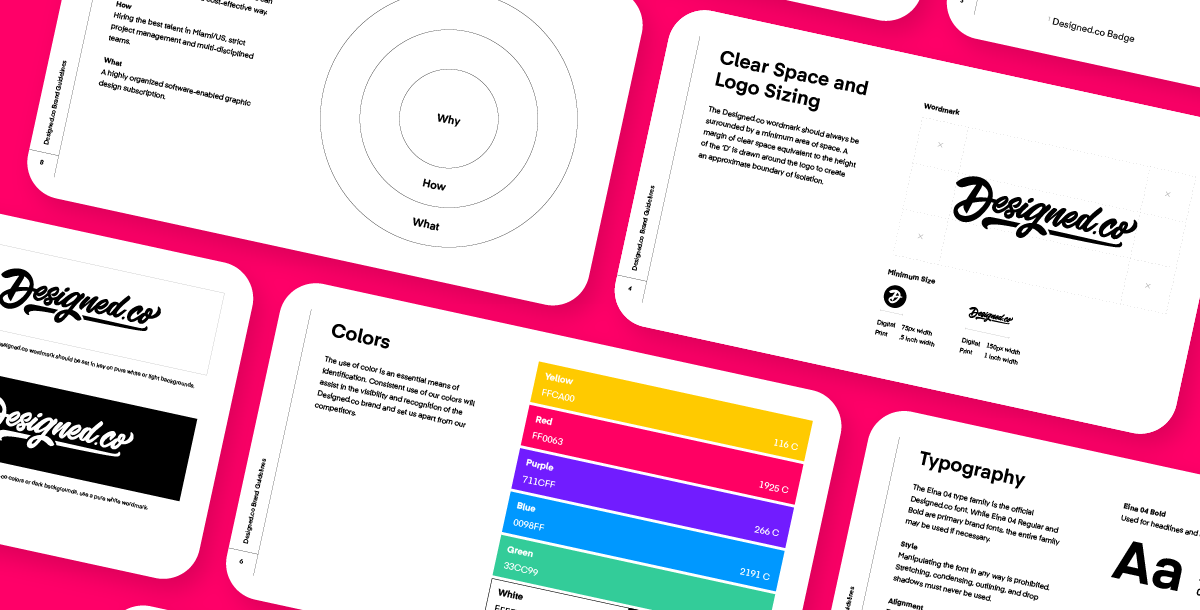Have you contemplated doing a refresh of your brand, or even defining your style and branding preferences more clearly?
I’ll let you in on a key rule we like to follow here at Designed.Co: brand and style guidelines are your friend. Having these documents to serve as guidelines will keep you on track so that your imagery and messaging is consistent.
Your brand is how your business is publicly perceived, so it’s important to be consistent across design work and messaging. This helps you to carve out a distinguishable niche in the minds of your customers and (hopefully!) give you a way to stand out from competitors.
Here’s what we mean by brand and style guidelines, and how they work:
Why are brand and style guidelines important?
Have you ever come across a company that you found to be confusing? Perhaps their overall look and messaging flip-flopped around to the point where it wasn’t recognizable. Maybe they seemed to always be trying different things, as though they were looking to see what would stick.
When this happens, it’s often a sign that the company hasn’t clearly defined what represents them as a brand. The aim is to occupy some space in the audience’s mind, preferably in a way that you’d like your brand to be thought of. Branding is who you are as a company, including tone, voice, content and style. If it’s inconsistent, you’ll confuse your audience and then, there’s that old adage that says “a confused mind never buys.”
Brand and style guidelines are important because they capture the essence of your brand and lay out the “rules” that you’ll follow to create designs and messages that are consistent and replicable. This helps you to build clear branding and establish trust with your audience.
A challenge for some of our clients is deciding what designs to use. Sometimes, if they have several great options, it can be difficult to choose. We’ve met many clients who had issues with keeping consistency in their branding, that is, until they had branding and style guidelines that helped them to make consistent choices.
Another great reason that having those guidelines is important is so that everyone you work with internally in your business is on the same page. Think about the different ways you interact publicly and any team members who are involved with that. Brand and style guidelines help them to be clear about how to implement your branding in their work.

by Designed.co
What’s the difference between brand and style guides?
Admittedly, you’ll often hear these two terms used interchangeably, but we see brand guides and style guides as two distinctive documents. The purpose of both is to lay out the style choices and correct uses for your brand.
A style guide is a shorter document – you could look at it as a sort of “cheat sheet.” It is often a one-page document which shows the recommended use of your company logo, typefaces or fonts and colors. A style guide is something that may have everyday uses in your company, including providing it to any media or partners. These are often the people who don’t do anything else with your brand apart from use your logo in an advertisement (or similar).
In contrast, a brand guide is a more comprehensive document, usually with multiple pages. This document goes in-depth, usually explaining brand strategy so that the internal users in your company have some context around use. It might define your company vision, values, culture and goals so that users of your guide can draw a direct line between these and your style preferences.
A brand guide is useful when you need more information to provide context to the people you work with, whether internally or in external creative teams. For example, if you are having a website redesign done externally, you might share your brand guidelines document with the team you’ve hired to do it.
Components of brand and style guides
Below are some basic components of brand and style guides:
Style guide components
- Your logo and any different versions of it.
- Any brand symbols you have.
- Your brand colors (including the HEX, RGB and CYMK numbers)
- Your brand typography. This should include font names and how you use them (e.g. bold, regular, italic)
- Any notes about how your logo and/or symbols are to be used. E.g. “the logo is only to appear in X color,” or “our symbol should only appear once on any page.”

by Designed.co
Brand guide components
Brand guidelines go into more depth with visual guidelines (how all content should be designed) and content guidelines (how written language should be used).
- All of the items included in a style guide, and;
- Outlines of your vision, values, goals and culture.
- Your buyer persona.
- Show primary and secondary colors (and where/how to use them)
- Guidelines for photography. (E.g. “all of our products should be photographed on a clean background in one of our secondary colors.”)
- Description and/or examples of your tone and voice.
- Any patterns you use.
- Guidelines for use in-print and on-screen. (You might have some very specific requests, e.g. “on our tote bags we use X logo in this way.”)
- Any specific guidelines such as what to do with the logo when it’s being used on a busy image.
Inspiration and examples
Here are examples of style or brand guidelines that companies have put together:
- Medium. The full brand guidelines can be found in the link. Note here the descriptive words they have used to paint a picture of their brand.
- Remode. See their brand guidelines created by Future-Form here. Note how they explain their color choices in the image below. This sort of description is a good way to share with any other creative teams you might work with.
- Ollo. This brand guideline by Bibleotheque Design showcases their originality and love of color. It’s a good example of a “fun” brand.

by Designed.co
Get started with your brand and style guidelines
You might be looking at all of this and wondering where to start to put together your own guidelines. The very first thing is to identify everything that needs to be included in your guidelines, from the heart of your brand to how you will communicate visually.
Provide examples for each item that should be included in your brand and style guidelines. Generally, you’ll have the most success in the work that is produced if people have strong context around any guidelines. Vague statements or anything left up to interpretation don’t tend to help!
You should also consider the format you’re going to create the guidelines in and where you will keep them. It’s important to have them easily accessible and shareable.
Do you need help putting together your own brand and style guidelines? This is something Designed.co has helped many clients with, along with almost any other design project. Book a demo with us here and find out how we can help!



